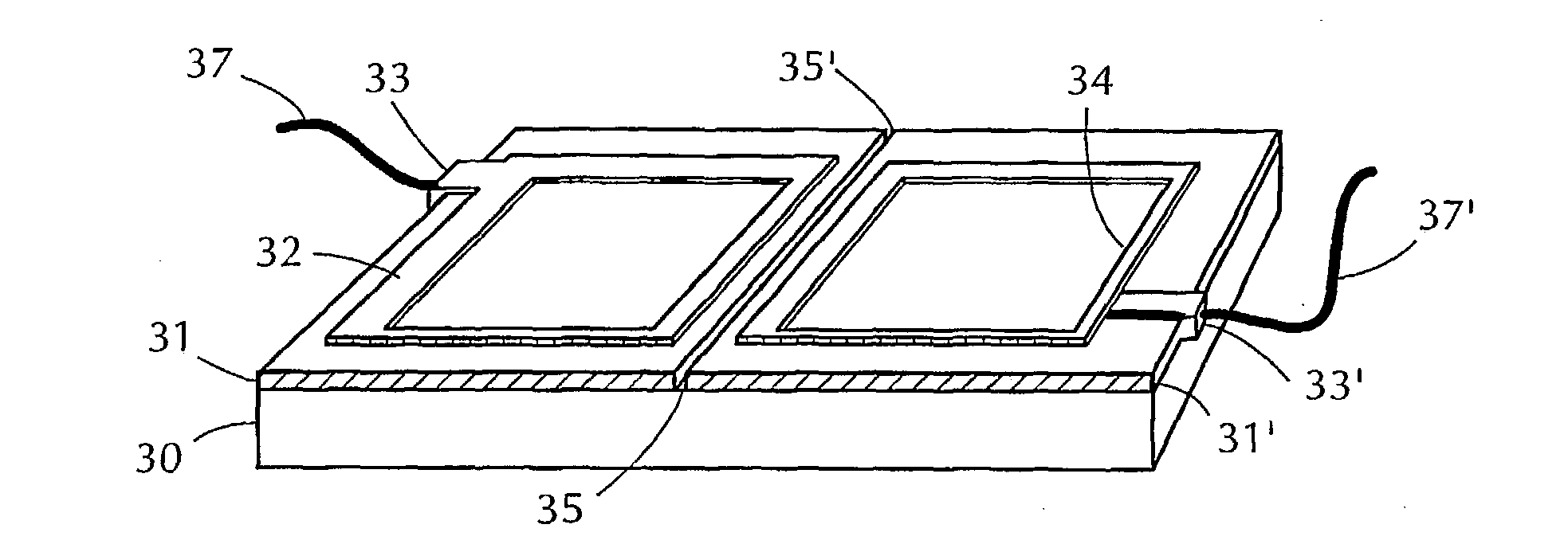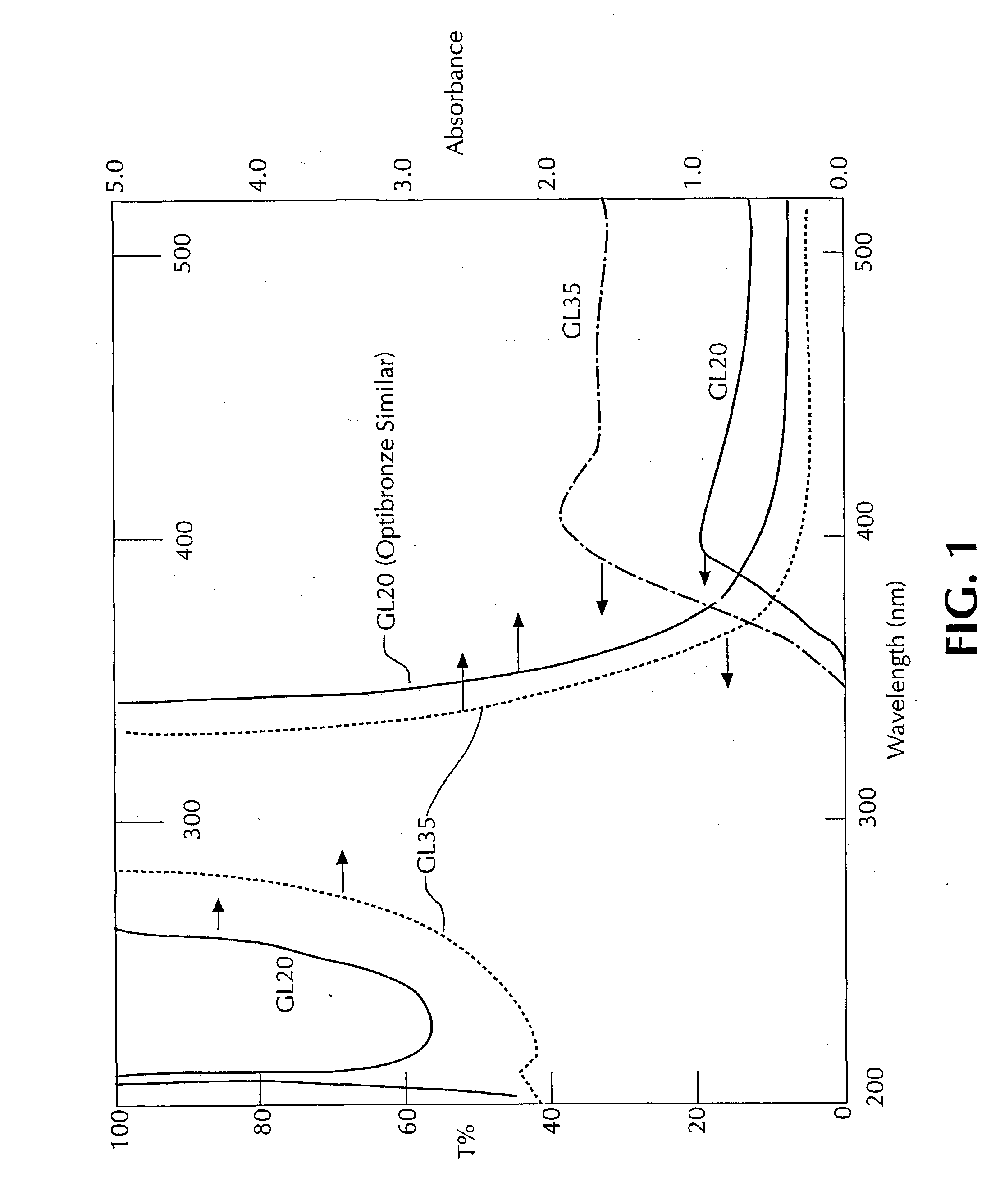Chromogenic glazing
a chromogenic glazing and chromogenic technology, applied in the field of chromogenic glazing, can solve the problems of affecting the color range of passengers, affecting the natural skin tone of passengers, and affecting the appearance of passengers' skin tone,
- Summary
- Abstract
- Description
- Claims
- Application Information
AI Technical Summary
Problems solved by technology
Method used
Image
Examples
example 2
Fabrication of an Electrochromic Device (Device 4) With Tungsten Oxide Electrochromic Layer and With Vanadium Oxide Intercalating Counterelectrode. These are Small Devices, Thus Prior Deposition of Busbars Such as Silver Frits is Not Required
[0117] A 3.times.3 inch (7.6 cm.times.7.6 cm) EC window device (Device 4) was made using TEC 15 (from Pilkington LOF, Toledo, Ohio). The tungsten oxide coating, lithium tungstate (Li.sub.0.3W)O.sub.x, was deposited, as described earlier, on TEC 15 glass. This is not a reduced form of tungsten oxide as lithium is present as an oxide. The thickness of the fired coating was 350 nm. Another piece of similar sized TEC 15 was coated with a vanadium oxide coating (counterelectrode). Both the electrodes in the cell store or intercalate ions. Both electrodes posses electrochromic properties, but the doped tungsten oxide imparts stronger coloration. This substrate had two small holes (about {fraction (1 / 16)} of an inch (1.6 mm)) about 1.5 cm from two of i...
example 3
Preparation of a EC Device (Device 5a,b) Which Uses LiMnNiO Counterelectrode
[0125] A solution to deposit LiMnNiO electrode was prepared as follows. 1.56 g of lithium methoxide was dissolved in 50 ml of distilled ethanol. Separately 9.28 g of Nickel(ll)ethylhexanoate (78% in 2 ethylhexanoic acid) and 18.81 g of manganese(ll)2-ethylhexanoate (40% in mineral spirits) were mixed and stripped off in a rotary evaporator (@90.degree. C.) of about 8.91 g of volatiles. After this 8.91 g of ethanol was added. The two solutions were then mixed together. After they dissolved in each other, a uniform phase was obtained which was used as a coating solution. The substrate (TEC15) was coated by spinning and then fired up to 450.degree. C. under conditions similar to the vanadium oxide described above. The coating thickness was 180 to 200 nm depending on the spinning conditions. A cell (Device 5a) was prepared with tungsten oxide as the other electrode as described above in the case of vanadium oxid...
example 4
Ultrasonic Sealing of Plug Holes
[0126] This is a novel sealing method to close the plug holes (fill ports) which is described in detail in the already filed patent application DE 100 06 199.0. The welding requires a cover or a plug to be placed on top of the plughole or inside the plughole. This cover (or plug) is then bonded on to the glass by fusing its surface with the glass surface. An ultrasonic oscillator rapidly provides the energy required to do this. The equipment employs a press to place the cover with a certain force covering the hole and contacting the substrate, transducers, ultrasonic generator and controller. An equipment supplier for such a system is Telesonic Ultrasonics (Bridgeport, N.J.) who sells such ultrasonic welding systems. The oscillations are typically rotational or translational with respect to the surface normal. In case of the present EC device the holes are plugged by covering them with thin foils or plates. These foils could be made out of a single ma...
PUM
| Property | Measurement | Unit |
|---|---|---|
| Length | aaaaa | aaaaa |
| Fraction | aaaaa | aaaaa |
| Angle | aaaaa | aaaaa |
Abstract
Description
Claims
Application Information
 Login to View More
Login to View More - R&D
- Intellectual Property
- Life Sciences
- Materials
- Tech Scout
- Unparalleled Data Quality
- Higher Quality Content
- 60% Fewer Hallucinations
Browse by: Latest US Patents, China's latest patents, Technical Efficacy Thesaurus, Application Domain, Technology Topic, Popular Technical Reports.
© 2025 PatSnap. All rights reserved.Legal|Privacy policy|Modern Slavery Act Transparency Statement|Sitemap|About US| Contact US: help@patsnap.com



